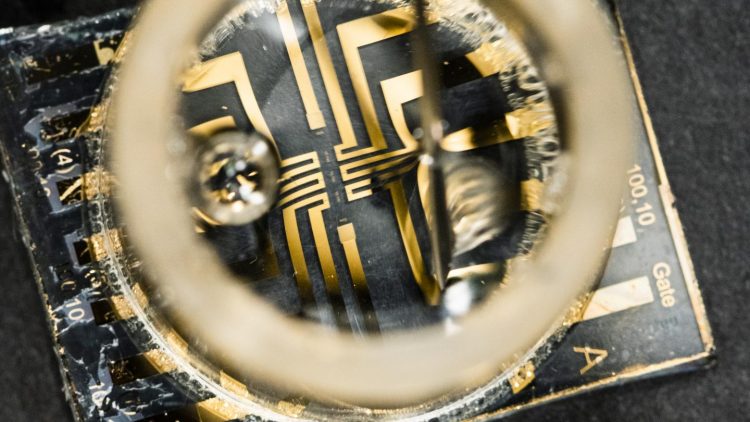Using tiny electrodes to measure electrical activity in bacteria

The organic electrochemical transistor in which the researchers have been able to deposit Shewanella oneidensis on one of the microelectrodes. Credit: Thor Balkhed Usage Restrictions: in connection with news from Linköping University
Scientists at Laboratory of Organic Electronics, Linköping University, have developed an organic electrochemical transistor that they can use to measure and study in fine detail a phenomenon known as extracellular electron transfer in which bacteria release electrons.
The study of bacteria and their significance for the natural world, and for human society and health, is a growing research field, as new bacteria are continuously being discovered.
A human body contains more bacteria than human cells, and a millilitre of fresh water can hold as many as a million bacteria.
Respiration in a normal human cell and in many bacteria takes place through biochemical reactions in which a compound, often glucose, reacts with oxygen to form carbon dioxide and water.
During the process, energy is converted to a form that the cell can use. In oxygen-free environments, bacteria are found that metabolise organic compunds, like lactate, and instead of forming water, they release, or respire, electric charges, a by product of metabolism, into the environment.
The process is known as extracellular electron transfer, or extracellular respiration.
The phenomenon is currently used in several electrochemical systems in applications such as water purification, biosensors and fuel cells. Adding bacteria is an eco-friendly way to convert chemical energy to electricity.
One such bacteria often used in research is Shewanella oneidensis, which previous research has shown to produce electrical current when fed with arsenic, arabinose (a type of sugar) or organic acids. A similar bacterium has recently been discovered in the human gastrointestinal system.
We do not, however, understand in detail what happens when bacteria release charges. In order to capture and measure the amount of charge released, electrodes are placed into the microbial systems.
An individual bacterium gives a very weak signal, and thus until now, researchers have had to be satisfied with studying extracellular electron transfer in large systems with large numbers of bacteria.
In order to increase our understanding, scientists at the Laboratory of Organic Electronics at Linköping University have employed a combination of microelectronics, electrochemistry and microbiology.
They have developed an organic electrochemical transistor in which they have been able to deposit Shewanella oneidensis on one of the microelectrodes, with a surface area of only a quarter of a square millimetre.
The amplification of the signal that occurs in the transistor makes it possible for them to study in detail what happens when various substances are added to the system. They describe in an article in Advanced Science experiments in which they fed lactate to the bacteria.
“We have shown that we can detect very small differences in extracellular electron transfer, in other words the amount of charge released by the bacteria. Another plus is that we can achieve very short response times, and obtain a stable signal within ten minutes”, says principal research engineer Gábor Méhes, who, together with senior lecturer Eleni Stavrinidou, is corresponding author for the article.
“This is a first step towards understanding extracellular electron transfer in bacteria occupying olny a small area with the help of a transistor, and how the conversion takes place between the bacteria and the electrode”, says Gábor Méhes. “One future goal is to learn how bacteria interact with each other, and with other cells and chemical substances in the human gastrointestinal tract.”
The research is being conducted within the framework of the Biocom Lab at the Laboratory of Organic Electronics, and is financed by Vinnova, the Swedish Research Council, the Swedish Foundation for Strategic Research, the Wallenberg Wood Science center and the European Research Council, ERC.
It is hoped that the research will lead to optimising microbial electrochemical systems that harvest energy, and increase our understanding of, for example, serious gastrointestinal conditions. Looking far inte the future, the idea has been raised among reserachers of using bacteria that respire iron compounds to support human life on the oxygen-free planet Mars.
###
Organic microbial electrochemical transistor monitoring extracellular electron transfer, Gábor Méhes, Arghyamalya Roy, Xenofon Strakosas, Magnus Berggren, Eleni Stavrinidou, and Daniel T. Simon, Advanced Science 2020, doi 10.1002/advs.202000641
Contact: Gábor Méhes, gabor.mehes@liu.se, +46 11 36 34 69
Media Contact
All latest news from the category: Materials Sciences
Materials management deals with the research, development, manufacturing and processing of raw and industrial materials. Key aspects here are biological and medical issues, which play an increasingly important role in this field.
innovations-report offers in-depth articles related to the development and application of materials and the structure and properties of new materials.
Newest articles

AI to improve brain cancer diagnosis, monitoring, treatment
Recommendations published in The Lancet Oncology call for good clinical practice of new technologies to modernize decades-old standard of care for brain cancer patients. An international, multidisciplinary team of leading…

AI tool ‘sees’ cancer gene signatures in biopsy images
AI tool reads biopsy images… To determine the type and severity of a cancer, pathologists typically analyze thin slices of a tumor biopsy under a microscope. But to figure out…

Skull bone marrow expands throughout life
…and remains healthy during aging. Blood vessels and stromal cells in the bone marrow create an ideal environment for hematopoietic stem cells to continuously produce all blood cells. During aging,…


